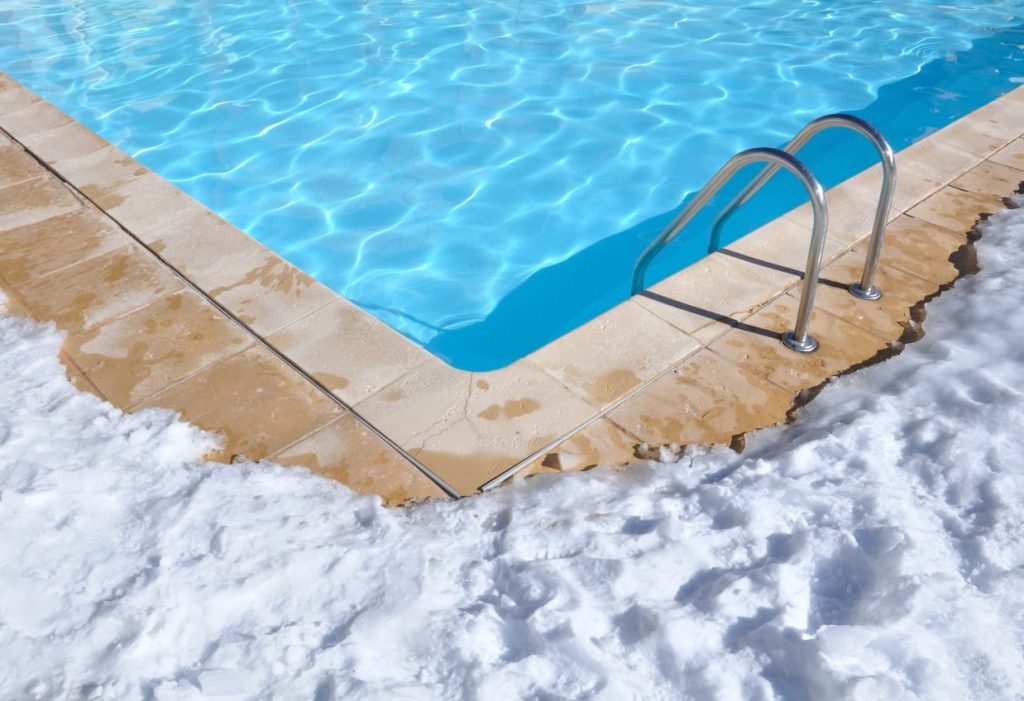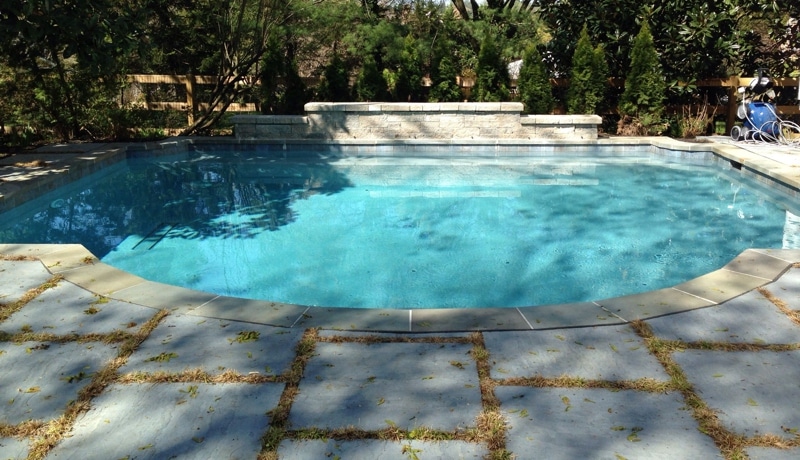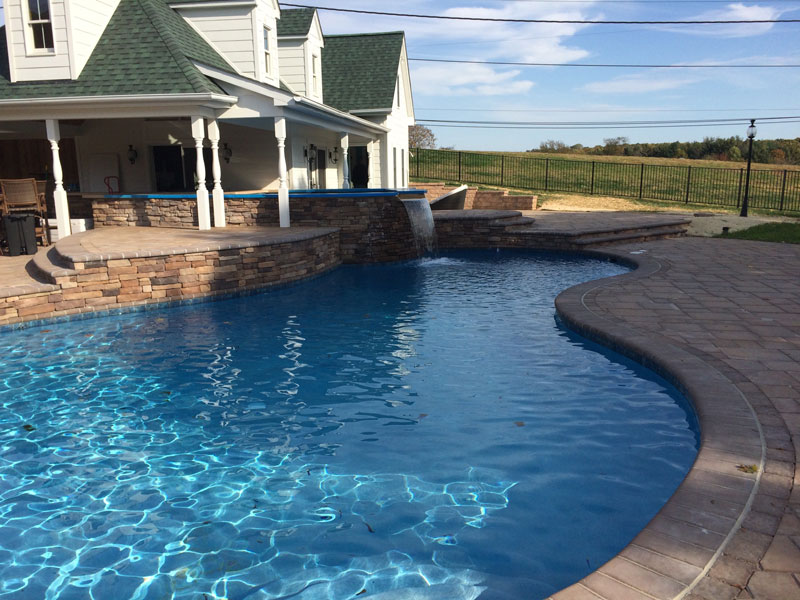Winters in the Mid-Atlantic are characterized by high winds, sub-freezing temperatures, and lots of snow and ice. For this reason, you should close and secure yours during winter to prevent the winter elements from damaging expensive pool equipment. Surface freezes can also tear through vinyl liners as a result of ice expansion.
Merely covering your pool without running a filter allows algae, bacteria, and chemical residue to build up over several months. These types of problems can be expensive to fix. To prevent these problems, you need to develop a plan to winterize your pool. The best approach is to hire a pool company in the Mid-Atlantic to provide professional pool maintenance during the fall.
Below, we provide some pool winterization tips to protect your pool from harsh cold weather.
Don’t Winterize Your Pool Too Soon
The best time to winterize your pool is during the fall when the temperature tops out at between 50 and 65 degrees Fahrenheit. Closing the pool too early increases the risk of mold and algae growth. If you allow algae to grow during the winter, you will have to clean it in the spring when you open the pool. The prolonged algae growth can damage your pool’s surface and ruin the professional finish.
1. Remove All Pool Accessories
The first step in winterizing your pool is to gather and store all detachable pool accessories, such as
- Skimmer baskets
- Cleaners
- Ladders
- Steps
- Solar blankets
- Vacuum
- Safety equipment
- Inflatables
- Toys
- Detachable lights
Try to clean and properly package all accessories before storing them. Store in a dry shelter out of the weather. Doing so keeps your accessories clean and protects them from the snow and ice.
2. Clean the Pool
Cleaning the pool thoroughly is essential to winterizing a pool. Follow these steps for cleaning your pool.
- Remove all debris with a skimmer.
- Brush or scrub the entire surface.
- Use a pool vacuum to collect small debris along the pool floor.
Cleaning the pool before winter removes debris and algae spores that have settled along the wall, floor, and openings. Use an algae brush to get any algae that may otherwise take root in the pool’s crevices or hard-to-reach areas. Once you are done, vacuum all that dirt and leave your swimming pool spotless before moving on to the next step.
3. Balance the Water Chemicals
Once you clean the pool, you will want to adjust the water chemistry five to seven days before you cover and close it. Levels should be as follows:
- Alkalinity: 80 to 150 ppm
- pH level: 7.2 to 7.6
- Calcium hardness: 175 to 225 ppm
- Chlorine level: 1 ppm to 3 ppm
If you need to increase the Total Alkalinity, add an alkalinity increaser such as sodium bicarbonate (baking soda), adding up to 25 pounds per 10,000 gallons of pool water. To decrease pH, use a pH decreaser such as sodium bisulfate or muriatic acid.
If you need to decrease the Calcium Hardness, partially drain your pool and refill it with fresh water. Also, use flocculants to collect excess calcium and a pool vacuum to remove the excess calcium.
4. Partially Drain the Water
If you live in the Mid-Atlantic region and you do not plan to cover your pool, you will need to drain some of the water. If you have a mesh cover, lower the water 10 to 12 inches below the skimmer. If you have a solid cover, lower the water five to seven inches below the skimmer.
Draining water from the pipes, filters, and pumps reduces the risk of freezing damage. However, you want to leave some water in the pool. Water protects the liner and the structure from cold weather damage. Your pool is specially designed to hold water regardless of the weather conditioner. Draining all the water can have an adverse effect. So only drain six to 12 inches and refill it next spring.
5. Drain and Dry the Pool Equipment
It is important to remove as much moisture from the pool equipment as possible to prevent ice buildup. Use a blower to clear the water from all pool lines. Afterward, use expansion plugs to prevent moisture from getting in the lines.
You can also reinforce the lines by adding antifreeze. Antifreeze ensures the lines do not crack or split due to freezing in the winter. A buried cracked line can be difficult to find without a special leak detection test, which can be costly to have done.
Completely drain the filters, pump, and heater. Each piece of equipment should be equipped with a plug for easy draining. Winterization is also the perfect time to remove and clean the pool equipment. If possible, store the filters and pump in a warm, dry area indoors.
6. Shock the Pool
The term shocking refers to the process of adding chlorine or non-chlorine chemicals to your pool to raise the free chlorine level to a point where it kills contaminants such as algae, combined chloramine, and bacteria.
You may have to shock the pool three to five days before you close the pool, depending on the type of shock you apply. Follow the package directions, and ensure you evenly distribute the chemicals around the pool instead of pouring them into just one area. If you’re using chlorine shock, don’t add it at the same time as the algaecide. Separate the application by a day or two.
Shock the pool after sundown. The sun’s UV rays burn off unstabilized chlorine, which means the shock won’t be as effective. Shocking your pool at night makes sure the chemicals work the way they were meant to.
7. Cover the Pool
Swimming pool covers protect your pool from falling or blowing debris and can protect against pool-related accidents. Covering your pool will also protect the shell of your pool in colder weather, making it less likely to crack than it would without a cover. In climates where the sun is a factor, using a pool cover can diminish the effects of the heat fading the paint and drying up or potentially cracking the concrete.
Standard winter pool covers are held in place using sandbags, blocks, or water bags, which can easily move if enough weight is exerted on the cover. For this reason, you’ll need a cover pump to keep water drained off the top so that it doesn’t accumulate too much weight and collapse into the pool.
Schedule Pool Installation with Elite Pools
If you are ready to install a pool in your backyard, we are ready to help. Elite Pools is your preferred swimming pool contractor in the Mid-Atlantic region. Contact us today and let us install or renovate your residential or commercial pool.
Please fill out our contact form or call us today for a free consultation or quote.




